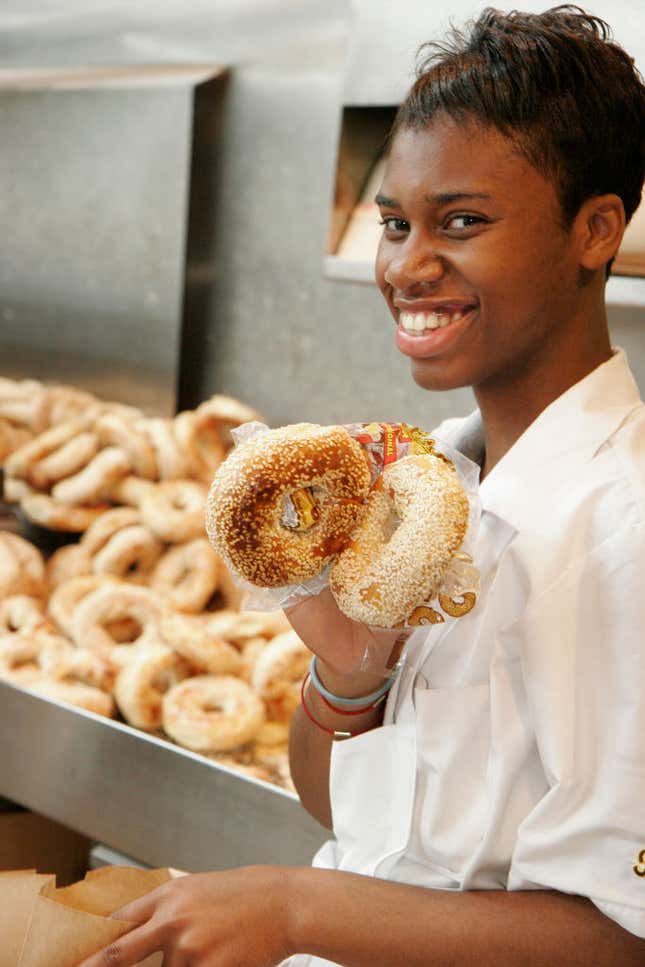
Rivalries run deep on the East Coast, and one rift that’s less visible—but every bit as heated—is the bagel feud between New York City and Montreal. As someone who grew up between the two cities in Connecticut, I’ve felt my allegiances tugged from both directions. My mother, being that she is from Montreal, tipped the scales. We never left the city without a few dozen bagels squirreled away among the packed luggage. Our freezer at home would run over with these dense, glutenous treats, and when we had them in the house, they were all I wanted to eat.
I will go to my grave defending the superiority of the Montreal bagel, but I really shouldn’t have to. Montreal bagels are more than just a bread product: They’re a cultural touchstone, the apotheosis of the bagel form. Show me another bagel that’s been to space.

Bagels originated in Jewish communities in Poland and began cropping up in New York and Montreal around the turn of the 20th century. At the time, there was a uniformity to the baking process: Bagels were rolled by hand and boiled in water before being cooked in wood-burning ovens. At some point, however, New York bakers succumbed to the allures of technology (some, not all) and began baking their bagels with gas and electric ovens.
Today New York and Montreal bagels are so different that they barely qualify as the same species. New York bagels are bigger, more pliable (New York City tap water has very low levels of calcium carbonate and magnesium, which produces softer gluten), and salty. Montreal bagels are sweeter (bakers add sugar to the dough, which, once rolled, is poached in honey-infused water), smaller, and crispier, with a chewy interior. Many Montreal bakers still hand-roll their bagels and cook them in the same wood-burning ovens they used when they first built their shops. You could knock the Montreal bagel for having a larger center hole, which means less surface area for toppings, but that would be an acknowledgment that you need cream cheese or other accoutrements to accompany the bagel. A Montreal bagel stands on its own.
But as divisive as the bagel rivalry is between these two cities, it’s nothing compared to the long-standing bagel feud between Montreal’s two bagel titans: St-Viateur Bagel and Fairmount Bagel. Both shops are located in the Mile End, a neighborhood known for its high concentration of hipsters, thrift stores, and Jewish people—it’s basically Brooklyn with Quebecois French.

My cousin Josh, a Montreal teacher and bagel enthusiast, tells me bagel shop allegiances are passed down through generations. Our family is loyal to St-Viateur, and when I ask him why some people prefer Fairmount, he tells me they were improperly raised. Even among die-hard Montreal bagel fans, differentiating between the offerings at these two shops is almost impossible. Josh’s fiancé, Allison, a pastry chef and food blogger, tells me Fairmount bagels skew thicker, but that on any given day, depending on which baker is rolling the bagel, the winner could be either shop.
Vince Morena, the president and owner of St-Viateur Bagels, says a Montreal bagel is defined by “the whole process,” adding, “It’s not just putting [bagels] in a machine with a timer and an oven.” In Montreal, bagel making is a craft and bagel makers are artisans. The bakers at St-Viateur work with master bakers—some of whom have been with the company for more than 20 years—for three months before they’re permitted to operate the ovens. Wood-burning ovens don’t have temperature gauges, so bakers rely on experience and gut instinct to deliver the golden-hued product that patrons have come to expect.

Demand for Montreal bagels is high, both inside and outside the city. When Josh would visit his ex-girlfriend in New York City, he would smuggle in bagels from Montreal, which the two would peddle at an incredible markup. Within Montreal, bagels are social currency; eight dollars will buy you a dozen, and people bring them to housewarming parties and wakes or use them to bribe friends into helping them move.
Both St-Viateur and Fairmount are open 24 hours a day, and it’s not uncommon to find lines out the door at 2 a.m. Said Morena, “One of the quintessential Montreal things to do is walk in and get a hot bagel right out of the oven and eat it right there.” Rarely does a full bag of a dozen bagels make it all the way home.
There’s no right way to eat a Montreal bagel, but there is an incorrect one: Allison says that people who patronize bagel shops and order anything other than sesame seed or poppy seed bagels are “doing it wrong.” Many people—Morena included—prefer their bagels toasted, then layered with cream cheese and smoked salmon.
Montreal bagels don’t come presliced, so a good bagel cutter is an invaluable tool.
Before I married my husband, I analyzed our relationship, looking for potential pitfalls. I was delighted when I realized our worldviews almost completely aligned—but it never occurred to me to solicit his opinions on bagels. As luck would have it, he’s a die-hard New York bagel fan. I still don’t know how we’re going to raise our children.